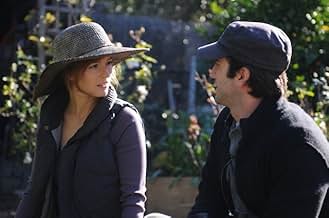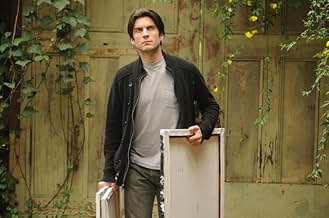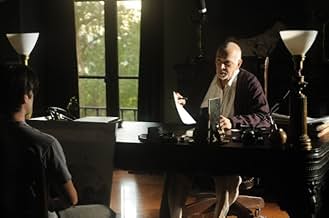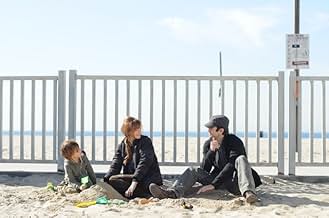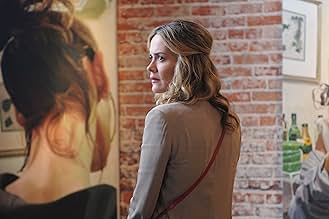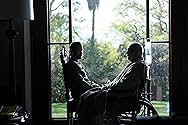Ajouter une intrigue dans votre langueA struggling young artist meets a mysterious and wealthy benefactor, who offers him a series of increasingly bizarre surveillance assignments.A struggling young artist meets a mysterious and wealthy benefactor, who offers him a series of increasingly bizarre surveillance assignments.A struggling young artist meets a mysterious and wealthy benefactor, who offers him a series of increasingly bizarre surveillance assignments.
- Réalisation
- Scénario
- Casting principal
- Récompenses
- 1 victoire au total
Avis à la une
3mbs
Frank Langella would very, very much be the reason to see this film, he doesn't disappoint...its the film around him that disappoints. Playing his somewhat usual unusual role of enigmatic rich man asking mysterious favors of a somewhat struggling younger person while hiding his own questionable agenda (see also "The Ninth Gate" and "The Box" among others.) Langella shows up on screen maybe ten minutes in snapping at his maid to go the pharmacy after she literally just said she was going there--- He then follows up with the memorable one liner "Life's a lot less complicated ever since I stopped hearing women talk" Its the kind of irresistible barbed one liner that i love hearing come out of Langella in movies exactly like these, and as he went about describing just exactly what he wanted from the young painter whose time and energy he solicits, I was more then wrapped up in the whole mysterious vibe of the film and quite optimistic.
Unfortunately the film as a whole seems a lot more interested in the process of painting and saddling Langella with somewhat ominous monologues with grave overtones about the importance of living while doing what you love while you can. I mean the writer/director gives Langella a good reason for doing that but its possible it could've been done in a somewhat less ham fisted way. While the creation of the various canvases that lead Wes Bentley gets to somewhat lovingly paint are tied in nicely with the main plot line, and the repeated close-ups of paint mixing with water are a neat visual motif (i suppose) its definitely not what i went to this movie to see, but its possible that I went to see this because I just wanted to see what nutty thing the Frank Langella character wanted from the younger character this time around.
What Langella wants is fairly easy to guess and one nice thing on the director's part is that he that he lets Wes Bentley understand almost immediately from the second he sees Sarah Paulson exactly what Langella wanted. The climactic scene of Bentley and Paulson together is nicely effective and reasonably free of the hitting you over the head emotionalism that a lesser director would've went for. When the film ends however you kind of realize that not a whole lot really happened and that the journey that Wes Bently made and the lessons he's supposed to have learned regarding the way he's been living his life don't feel all that true. Even tho i did like the performance of the actress who played his wife (Ahna O'Reily) who i thought did a very effective job showing the frustrations living with this obsessive painter was having on her life during the couple of scenes she was in. (Or as Langella says to Bentley regarding her "Artists can't have families, it takes away from their art") Honestly i just think the film either needed more meat to its rather slim story, or failing that more maybe some more substantial scenes between Bentely and Langella--I'm not entirely sure what this film needed more of but i definitely feel like it needed more of something for it to have felt worth watching and thinking about as a whole but OK.
Unfortunately the film as a whole seems a lot more interested in the process of painting and saddling Langella with somewhat ominous monologues with grave overtones about the importance of living while doing what you love while you can. I mean the writer/director gives Langella a good reason for doing that but its possible it could've been done in a somewhat less ham fisted way. While the creation of the various canvases that lead Wes Bentley gets to somewhat lovingly paint are tied in nicely with the main plot line, and the repeated close-ups of paint mixing with water are a neat visual motif (i suppose) its definitely not what i went to this movie to see, but its possible that I went to see this because I just wanted to see what nutty thing the Frank Langella character wanted from the younger character this time around.
What Langella wants is fairly easy to guess and one nice thing on the director's part is that he that he lets Wes Bentley understand almost immediately from the second he sees Sarah Paulson exactly what Langella wanted. The climactic scene of Bentley and Paulson together is nicely effective and reasonably free of the hitting you over the head emotionalism that a lesser director would've went for. When the film ends however you kind of realize that not a whole lot really happened and that the journey that Wes Bently made and the lessons he's supposed to have learned regarding the way he's been living his life don't feel all that true. Even tho i did like the performance of the actress who played his wife (Ahna O'Reily) who i thought did a very effective job showing the frustrations living with this obsessive painter was having on her life during the couple of scenes she was in. (Or as Langella says to Bentley regarding her "Artists can't have families, it takes away from their art") Honestly i just think the film either needed more meat to its rather slim story, or failing that more maybe some more substantial scenes between Bentely and Langella--I'm not entirely sure what this film needed more of but i definitely feel like it needed more of something for it to have felt worth watching and thinking about as a whole but OK.
The only good performance in this movie is Frank Langella. And there are much better films of his to watch. This one reminded me of a student film shot by a film student with little to no talent. The script is mediocre at best. The performances are wooden. There's nothing special about the cinematography. All in all just a big time waster. Its the kind of independent film TV actors make when the show they're making a living off of is on hiatus and they don't want to sit around doing nothing. There is honestly nothing to this film. Its 85 minutes of actors going through the motions. And the actor who played the artist is probably one of the most uninspriring actors of all time. Maybe if we were still in the silent film era a good director could get a good performance out of him just focusing on his eyes. But once he opens his mouth and starts talking. Ugh.
So I decided to look up Wes Bentley movies and picked this one to watch because it sounded interesting to me. I'm a sucker for artistic things. The whole vibe of this film was really interesting, it had this strange but at the same time kind of comforting atmosphere. Wes Bentley was great as a struggling artist who loves his family but feels the pressure to provide for them and it puts a strain on his relationshipwithhis wife and son. I'll leave it at that, I don't want to spoil anything. If you're looking for a fast paced movie, this probably isn't for you, but if you enjoy art I feel like it could be.
a great actor. a strange subject. nuances of atmosphere. all as bones and flesh of a movie who can remember Lucian Freud art or American Beauty.it is a film from images and silence. a kind of parable. or only a lesson.Frank Langella is the locomotive of this interesting project. Sarah Paulson - the delicate spice.Wes Bentley- only a silhouette lost in middle of details. it is a beautiful movie. not exactly good. only beautiful. a kind of embroidery, a precise puzzle, a story about choices, maybe, version of Faust pact. the best ingredient - expectation of viewer. the worse - hope to remark Wes Bentley in a special role. but director intuition remains remarkable - Frank Langella is the best and the others, including the script, may be his mirrors.
Many years ago, a women's magazine featured a list of the sort of men women should avoid marrying. Heading that list were artists. The reason given was that artists marry to take care of all the basic and mundane things in their lives (possibly including sex) so that they can get on with what they really want to do - their art.
Although the article was slightly tongue-in-cheek, this beautifully made film bears the theory out perfectly.
Daniel (Wes Bentley), a struggling artist is having trouble supporting his family. When he delivers a painting to Warner Dax (Frank Langella), a wealthy old man he thinks could become a benefactor, his life undergoes a remarkable change.
At first, Warner commissions him to undertake a series of bizarre surveillance exercises, which seemingly have little to do with art. We suspect that there could be a malevolent motive behind this, especially when Daniel loses his job, and nearly his family. Eventually everything drops into place and we see that rather than a sinister figure, Warner is actually a mentor who offers Daniel a chance to lead a more satisfying life.
Apparently the film was made on a ridiculously small budget, but it doesn't show; low key and moody, the story unfolds at a measured pace.
The art in the film is woven into the texture of the story in a unique way. There is one painting of Warner Dax against a background of brambles, which makes a salient point about how the character sees his life. The names of the artists who executed the powerful paintings in the film appear in the end credits: original paintings created by Eric Zener and Stephen Wright.
Love of art shows through in every frame of "The Time Being", including the atmospheric score by Jan A.P. Kaczmarek. In an interview, writer/director Nenad Cicin-Sain said that in his youth he had been involved in various forms of art, "When I was in my late twenties I formed a partnership with a painter who was ultimately one of the people who did a lot of the paintings in the film, underwater painting".
Presumably this was Eric Zener who provided the art for Wes Bentley's character. The bold figure work we see a little later in the movie, some of which seems like a modern take on the paintings of Lucien Freud, is by Stephen Wright. It's also worth noting that during the painting scenes, the actors seem to know their way around a brush and canvas, applying the paint in a convincing manner.
"The Time Being" celebrates the art of film as much as the impressive artwork within the story. It is a movie that sneaks up on you; I was sorry when it ended. Those who don't normally go for this sort of thing may find it a welcome change of pace.
Although the article was slightly tongue-in-cheek, this beautifully made film bears the theory out perfectly.
Daniel (Wes Bentley), a struggling artist is having trouble supporting his family. When he delivers a painting to Warner Dax (Frank Langella), a wealthy old man he thinks could become a benefactor, his life undergoes a remarkable change.
At first, Warner commissions him to undertake a series of bizarre surveillance exercises, which seemingly have little to do with art. We suspect that there could be a malevolent motive behind this, especially when Daniel loses his job, and nearly his family. Eventually everything drops into place and we see that rather than a sinister figure, Warner is actually a mentor who offers Daniel a chance to lead a more satisfying life.
Apparently the film was made on a ridiculously small budget, but it doesn't show; low key and moody, the story unfolds at a measured pace.
The art in the film is woven into the texture of the story in a unique way. There is one painting of Warner Dax against a background of brambles, which makes a salient point about how the character sees his life. The names of the artists who executed the powerful paintings in the film appear in the end credits: original paintings created by Eric Zener and Stephen Wright.
Love of art shows through in every frame of "The Time Being", including the atmospheric score by Jan A.P. Kaczmarek. In an interview, writer/director Nenad Cicin-Sain said that in his youth he had been involved in various forms of art, "When I was in my late twenties I formed a partnership with a painter who was ultimately one of the people who did a lot of the paintings in the film, underwater painting".
Presumably this was Eric Zener who provided the art for Wes Bentley's character. The bold figure work we see a little later in the movie, some of which seems like a modern take on the paintings of Lucien Freud, is by Stephen Wright. It's also worth noting that during the painting scenes, the actors seem to know their way around a brush and canvas, applying the paint in a convincing manner.
"The Time Being" celebrates the art of film as much as the impressive artwork within the story. It is a movie that sneaks up on you; I was sorry when it ended. Those who don't normally go for this sort of thing may find it a welcome change of pace.
Le saviez-vous
- Citations
Warner Dax: Well, Daniel, do you have the footage I asked for?
Meilleurs choix
Connectez-vous pour évaluer et suivre la liste de favoris afin de recevoir des recommandations personnalisées
- How long is The Time Being?Alimenté par Alexa
Détails
Box-office
- Montant brut aux États-Unis et au Canada
- 5 274 $US
- Montant brut mondial
- 5 274 $US
- Durée1 heure 25 minutes
- Couleur
Contribuer à cette page
Suggérer une modification ou ajouter du contenu manquant

Lacune principale
By what name was The Time Being (2012) officially released in Canada in English?
Répondre

